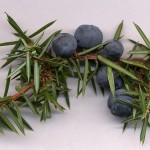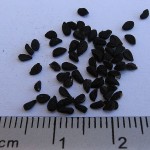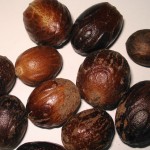
Kitchen spices as medicine are a green way to get a useful, and always on hand supply, when you need it. Choose organic when you can.
This is the third post in a series on medicinal spices. You can read Part I and Part II by following the above links. If you’re a Green Prophet, you know that simplifying your life and using less chemicals can be good on you and the environment. Heading through the alphabet, today, we’re discovering the surprising properties of H to N: the value of hyssop, juniper berries, nigella, and nutmeg/mace.
 Photo of flowering hyssop by Armin Jager via Wikipedia
Photo of flowering hyssop by Armin Jager via Wikipedia
Hyssop is a slightly bitter spice that isn’t much used in cooking these days. Its strong flavor, something like sage and something like mint, is best suited to hearty stews, roasts, and soups.
Yet hyssop has several medicinal uses. Notably, it’s an effective antiseptic. Tea made from it heals sore throats and soothes coughs by loosening mucous. We haven’t tried this, but it’s said that tea of hyssop, applied as a poultice (soak a big wad of cotton or a clean cloth in it) will bring down the inflammation of a black eye. Hyssop is part of the Labiatae botanical family, and like all the Labiatae, it’s helpful in soothing indigestion, flatulence, and stomach aches.throats and soothes
With it’s useful properties come warnings, though: according to the Plants for a Future database, hyssop tea may
…irritate the mucous membranes, so it is best given after an infection has peaked, when the herb’s tonic action encourages a general recovery[254]. The plant should not be used by pregnant women, however, since in large quantities it can induce a miscarriage.

Photo via Wikipedia
Juniper berries are known as a flavoring in Scandanavian cuisine, but the plant is native in the Mediterranean as well as in Northern Europe and the U.S. The characteristic aroma of gin comes from juniper (we are convinced that an ice-cold gin and tonic is a very medicinal thing to drink, of a summer’s evening). Juniper berries are diuretic and helpful in controlling arthritis and rheumatism.

Photo of Nigella seed by The Goblin via Wikipedia
Nigella is sometimes, confusingly, referred to as black cumin, black onion seed, or black caraway. Stick with local names for this little black seed – ketzach in Hebrew, habbat al-barakah in Arabic. Or if shopping for it outside of the Middle East, nigella sativa. In the Middle East, we enjoy its pungent taste sprinkled on breads and crackers.
In the Arab world, nigella is said to cure everything except death. It’s used as a folk medicine to treat respiratory and intestinal ailments, abcesses, kidney stones, and parasitic infections. The oil expressed from the seeds is used as treatment for eczema and other skin irritations. We can attest to the power of nigella tea as a galactogogue (a remedy that helps nursing mothers produce milk).

Photo of nutmegs via Wikipedia
Nutmeg is the seed inside a pulpy fruit, and mace the lacy membrane covering the nut. When the tender mace is separated from the nut, it hardens. This is the only fruit that yields two spices. Sprinkled over eggnog or other hot drinks, both help relieve nausea and vomiting. According to the herbalist Maude Grieve, “Grated nutmeg mixed with lard makes an excellent ointment for piles.”
All mention of nutmeg and mace carry the same warning: large doses, meaning even one-half of a nut, are proven to be narcotic and toxic. Back in the late 1960s, people discovered its mild hallucinogenic properties and thought it would fun to get high on on it – only to find out that it made them sick with extreme nausea that lasted for days, due to liver damage.
Keep with the pinch of powdered spice sprinkled over your hot drink, as folks have enjoyed it for centuries, and you’ll be fine.
Like cooking “green”? See more earth-friendly recipes:
Top photo of garlic by Miriam Kresh.



Hi Miriam,Wonderful information! I've always been intrigued by the medicinal properties of herbs and plants. To add to the information – nutmeg is also an aphrodisiac! In fact, there are a few commonly known aphrodisiacs native to our region of the world including avocado and pomegranate. Best, T